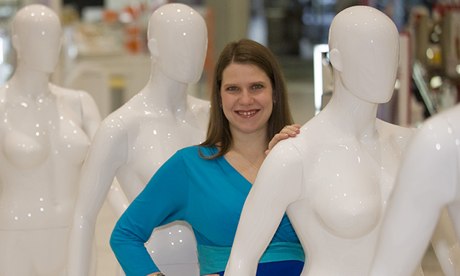
The average woman in the UK is 5ft 3in tall, weighs 11 stone (70.2kg) and wears a size 16. So the first thing to say about the mannequins launched today in department store Debenhams is that they are not "plus" size, they are bang on average.
So ingrained is the idea that the typical British woman must need to shop at a specialist retailer for chubsters that even the BBC suggests that size 16 is "plus size". With us all being constantly bombarded by images of tall, slender women from billboards, television screens and magazines, is it any wonder that the nation's biggest broadcaster thinks normality is represented by women so skinny that there's a gap between their thighs?
Which is why the use of size 16 mannequins in Debenham's flagship store in London's Oxford Street, the busiest retail street in Europe, is to be welcomed. First introduced for a two-week trial in 2010, it took the retailer three years to produce its 12 mannequins and which will be used alongside the size-10 mannequins that will still be the norm across its 170 stores nationwide.
Debenhams director Ed Watson says: "Having worked on this project for three years, we hope that it will help people in some small way to feel comfortable about their bodies and, crucially, that other retailers will follow."
He may not have said as much, but using average-sized women is also good for business. A recent study from Toronto found that women are three times more likely to buy clothes when the models in advertisements were their size. Widespread use of airbrushing and unhealthily thin models appears to be waning, according to the study by assistant professor Ben Barry.
"Girls and women are sceptical of the thin ideal, digital manipulation, tokenism of diversity and stereotypical messages about age, race and gender," says the report. "They trust advertising that depicts healthy body shapes, realistic signs of age and size, as well as authentic and positive representations of diversity."
Equalities minister Jo Swinson, who launched her own body image review and has done a lot to raise awareness about the issue, welcomed the Debenhams move, saying: "I hope more retailers will recognise that meeting customer demand for more diversity makes good business sense. Many customers want to see more realistic images in magazines, TV and on the high street, and having mannequins that reflect and celebrate our diverse society is one way of helping to achieve this."
So why is Debenhams still rare in having vowed to stop airbrushing, using a size 18 model for its lingerie to "celebrate curves" and for using several models over the age of 40 – including one nearing 70 – and a paralympic athlete to advertise its fashion range? Bigger retailers with a younger market, such as Top Shop, still use tall, size 10 mannequins that bear little or no relation to many of their actual customers. But then again the retailer is about to launch a new range in its lucrative association with a model, Kate Moss, who is famous for saying: "Nothing tastes as good as skinny feels."
Perhaps separately, statistics from campaigners Body Gossip suggest one in 10 young people will develop an eating disorder before they reach the age of 25 (with 1.6 million currently officially diagnosed in the UK).
Natasha Devon, co-director of the group, says we need to fight against the idea that there is one ideal kind of body shape: "We don't want plus-sized models, which could create their own paradigm, but a whole range of body types."
Debenhams made me glad today, but the picture that really cheered me is one of a gorgeous seven-year-old called Holly Greenhow. The little girl has appeared modelling Boden clothes today, the first child to do so whose cerebral palsy makes use of a wheelchair necessary. Her mother Fiona told the Telegraph: "Holly has a beautiful smile and modelling is not all about being perfect, so we thought why shouldn't she be considered." Why not indeed.

